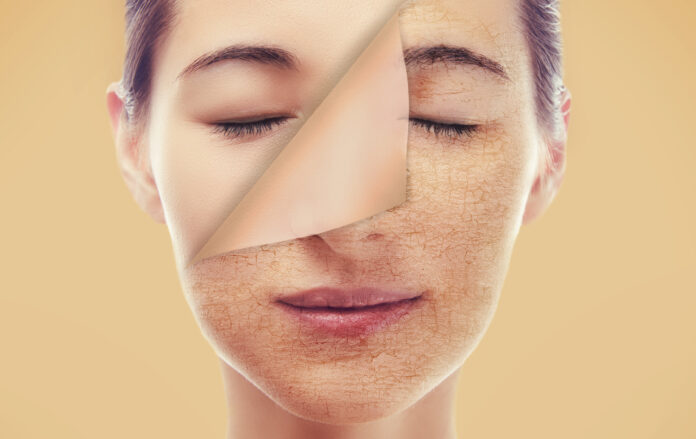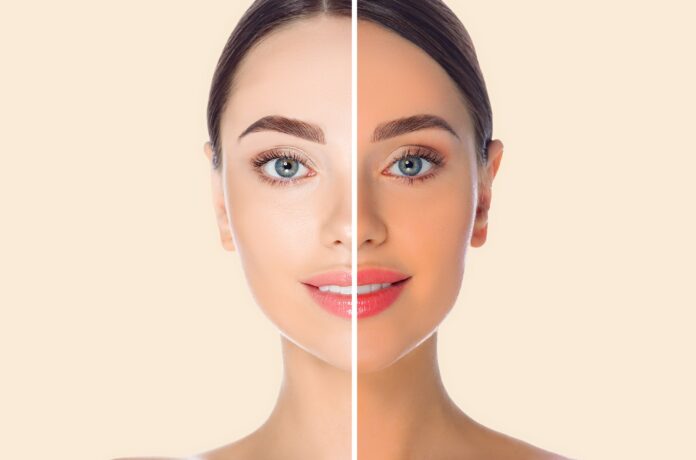Tanning is one way of making your skin from looking dry and pale to tan and smooth. But it might be a very long process if you have fair skin.
Here is a guide on how to tan fair skin safely and effectively.
Exfoliate
This is the first crucial step in tanning. Exfoliating your skin involves removing dead skin cells.
These dead skin cells can get in the way of the tanning process. Once they fall off, you might end up having white spots, making the whole thing look off.
There are two ways to exfoliate, physically and chemically.
Physically exfoliation means manually scrubbing off dead skin cells using exfoliants like scrubs and brushes.
On the other hand, chemical exfoliation uses acids such as AHAs (alpha-hydroxy acids) and BHAs (beta-hydroxy acids) to remove dead skin cells. Examples include salicylic acid and glycolic acid.
Even if chemical exfoliants are safe, it is still best to manually scrub the dead skin cells if you have sensitive skin.

Moisturize
Moisturizing is another integral part of the tanning process. This should be done before and after tanning.
Tanning without moisturizing will leave your skin dry and wrinkled because of the sun’s heat.
Using thicker creams are best for with a dry skin type, while gel moisturizers would be more suitable for those with combination or oily skin types.
Another way of moisturizing is drinking water. Drinking water rehydrates the entire body, and that includes the skin. Now, you can add skin moisturizing to the list of why drinking water is important.
Sunscreen
Getting tanned skin should not come at the cost of getting sunburn. While ultraviolet (UV) light can make your skin tan, it can also damage it.
This is why sunscreen should be an essential part of your skincare routine in general, not just when tanning. Ensure that your sunscreen is broad spectrum and is at least SPF 30 for guaranteed protection from harmful UV rays.
Will this affect your tanning? Not at all. Sunscreen only protects your skin from burning and other negative effects of UV light. It does not go in the way of the melanin production process.

Tanning Lotions
Tanning lotion is another core ingredient in getting your tan.
There are different types of tanning lotions, such as tingle and cooling lotions.
You can also choose between tan accelerators (which can speed up the tanning process) or bronzers (which are filled with DHA for an immediate darker tan).
Tan Regularly
The tanning process will take a while, so don’t expect to get immediate results after a one-time tanning session. Depending on the pacing, you will need to do this for a few sessions.
At the same time, don’t tan every single day straight.
Doing this might cause your skin to burn, especially if you are tanning in a salon.
You need to let your skin rest and cool down for it to be effective and safe. Have a day of no tanning between two sessions for consistent results.
Add a minute or two for every subsequent session. However, also know the cap time for each type of tanning. The maximum time for sun tanning is thirty minutes, and the maximum time for indoor tanning is ten minutes.

Sun Tanning Tips
If you decide to tan via sun tanning, here are some tips that you will need to know.
The first thing to know is the peak hours of the sun. This is important because there are times when the sun’s rays are dangerous to expose yourself to for extended periods of time.
The peak hours that you should avoid are 10:00 am to 4:00 pm. During these hours, the sun’s rays emit strong UV light that will burn your skin if you stay in the same position for a long time.
The best time to tan is before 10:00 am and after 4:00 pm. Even if the sun still shines, it isn’t as harsh as during peak hours. So remember these times for your next tan.
The next tip is to constantly switch positions. Even if you tan when the sun isn’t harsh, staying in one position for extended periods of time will still burn your skin.
At the same, you might leave out other parts of your skin. This will make the tan look uneven. Switch positions every now and then to both even out the tan and protect your skin
Lastly, bring a timer with you while tanning. This is to indicate when to switch positions and to know when the tanning session is done.
Wear Goggles
Whatever method of tanning you do, always wear goggles. It is crucial to protect your eyes from UV light. Wear goggles with thin straps if you don’t want to obscure other parts of your face that the straps might cover.

Put Petroleum Jelly or Lip Balm with SPF
Another safety tip is to put petroleum jelly or lip balm with SPF on your lips to protect them from UV light.
Eat Well
You might not think much about this but eating certain foods actually helps speed up the tanning process.
Since tanning involves melanin production, eating foods that take care of this process will help.
Examples of food that increase melanin production are foods with vitamin A. These include carrots, sweet potatoes, spinach, fish, and meat.
Other types of food are those with vitamin C, so citrus fruits, leafy greens, and berries.

Frequently Asked Questions
Physical Exfoliant or Chemical?
There is no correct one. Even if physical exfoliants are more recommended for sensitive skin, either option is okay if your skin doesn’t react to chemical exfoliants that much.
Do a patch test for the exfoliant you are using to see if it works and doesn’t irritate your skin.
Are there specific tanning lotions for people with fair skin?
An accelerator should be enough after you get your base tan. That is if you want to deepen your tan.
If you are satisfied with the results of your base tan, then the bronzer should be okay.
How many visits to the salon should I have?
It will take about five to ten sessions if you have both fair and sensitive skin.
The maximum time for tanning is ten minutes so stay within that time.
Conclusion
The tanning process is not a one-time thing and the results will take some time before you can see them. Precautions should also be taken into account to avoid damaging your skin in the long run.
Always practice patience and care, and soon you will get that glowing tanned skin you’ve always wanted.

